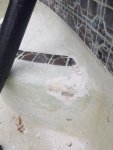Call me crazy but I'm going the DIY route on this one and have done a ton of research on cementious and membrane solutions and think I am going to go forward with a cement based solution.
If the knowledgeable people here could look at these pics of the popoffs and the rest of the plaster to give me their opinion on what the issues were with the old plaster that may help me plan better on how much needs to come off and what I may need to consider in materials selection.
For the popoffs seem to be powdery between the hard outer layer and the inner plaster but I am not sure if that is just old plaster or a reaction product, it is white just like the plaster. The inner plaster (kind of concreteish some places but I found the brown area a half inch under the white in one of the pics so I assume that is the real concrete) the white I think plaster is not difficult to remove by pushing on it with a chisel but it is pretty solid. Some inner parts of plaster have been stained a tan color from the underlying concrete I think.
My guess is this pool is from the 80's or 90's and may have been maintained well but the water levels were so high in every department that I dont think the last owners ever changed the water, at all. Alkalinity was very high and I think the CaCO3 Alkalinity is 154 ppm out of the tap already and Total CaCO3 Hardness is 248 out of the tap. They have probably been topping off forever too.
I need help diagnosing this and determining if all of it has to go, just the delaminating sections, or maybe "just" the thin hard outer finish.
Thank you so much!
If the knowledgeable people here could look at these pics of the popoffs and the rest of the plaster to give me their opinion on what the issues were with the old plaster that may help me plan better on how much needs to come off and what I may need to consider in materials selection.
For the popoffs seem to be powdery between the hard outer layer and the inner plaster but I am not sure if that is just old plaster or a reaction product, it is white just like the plaster. The inner plaster (kind of concreteish some places but I found the brown area a half inch under the white in one of the pics so I assume that is the real concrete) the white I think plaster is not difficult to remove by pushing on it with a chisel but it is pretty solid. Some inner parts of plaster have been stained a tan color from the underlying concrete I think.
My guess is this pool is from the 80's or 90's and may have been maintained well but the water levels were so high in every department that I dont think the last owners ever changed the water, at all. Alkalinity was very high and I think the CaCO3 Alkalinity is 154 ppm out of the tap already and Total CaCO3 Hardness is 248 out of the tap. They have probably been topping off forever too.
I need help diagnosing this and determining if all of it has to go, just the delaminating sections, or maybe "just" the thin hard outer finish.
Thank you so much!






